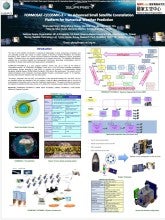FORMOSAT-7/COSMC-2 – an Advanced Small Satellite Constellation Platform for Numerical Weather Prediction
Chen-Joe
Fong
National Space Organization (NSPO)
Poster
The role of small satellite constellation in operational meteorology is being increasingly considered, and can potentially provide high impact on certain aspects of Numerical Weather Prediction and weather forecasting. Such systems can provide important additional information addressing specific geographic regions, or address some very specific applications at a suitable price point. This capability has become possible due to innovative payload and measurement techniques, technology miniaturization, and the availability of reliable small satellite technology used in constellations.
FORMOSAT-7/COSMIC-2 is a joint program between Taiwan and US to serve as the follow-on “Operational Mission” of FORMOSAT-3/COSMIC, which was a joint US-Taiwan 6-satellite constellation demonstration mission launched in April 2006, to continue the provision of next-generation Global Navigation Satellite System (GNSS) Radio Occultation (RO) data to the global users. The mission aims to collect atmospheric and ionospheric soundings globally through a constellation system of 12 satellites, providing high temporal resolution and high data quality.
The design, integration and test (I&T), and verification of the spacecraft heritage from the SSTL-100 bus are important drivers and selected in this joint system in order to obtain measurement data in time for the meteorological forecasting cycle to meet the challenging requirements. This paper provides an overview of the satellite constellation which were carried out to achieve the necessary system design and performance.
FORMOSAT-7/COSMIC-2 is a joint program between Taiwan and US to serve as the follow-on “Operational Mission” of FORMOSAT-3/COSMIC, which was a joint US-Taiwan 6-satellite constellation demonstration mission launched in April 2006, to continue the provision of next-generation Global Navigation Satellite System (GNSS) Radio Occultation (RO) data to the global users. The mission aims to collect atmospheric and ionospheric soundings globally through a constellation system of 12 satellites, providing high temporal resolution and high data quality.
The design, integration and test (I&T), and verification of the spacecraft heritage from the SSTL-100 bus are important drivers and selected in this joint system in order to obtain measurement data in time for the meteorological forecasting cycle to meet the challenging requirements. This paper provides an overview of the satellite constellation which were carried out to achieve the necessary system design and performance.

Poster PDF
Presentation file
Abstract file